Electrical Measuring Instruments Principle of Operation
Electrical Measuring Instruments Principle of Operation depends for their action on one of the many physical effects of an electric current or potential and are generally classified according to which of these effects is utilized in their operation (Electrical Measuring Instruments Principle of Operation). The effects generally utilized are :
1. Magnetic effect – for ammeters and voltmeters usually.
2. Electrodynamic effect – for ammeters and voltmeters usually.
3. Electromagnetic effect – for ammeters, voltmeters, watt meters and watthour meters.
4. Thermal effect – for ammeters and voltmeters.
5. Chemical effect – for d.c. ampere-hour meters.
6. Electrostatic effect – for voltmeters only.
Another way to classify secondary instruments is to divide them into
(i) indicating instruments
(ii) recording instruments and
(iii) integrating instruments.
Indicating instruments are those which indicate the instantaneous value of the electrical quantity being measured at the time at which it is being measured. Their indications are given by pointers moving over calibrated dials. Ordinary ammeters, voltmeters and watt meters belong to this class. Recording instruments are those, which, instead of indicating by means of a pointer and a scale the instantaneous value of an electrical quantity, give a continuous record or the variations of such a quantity over a selected period of time. The moving system of the instrument carries an inked pen which rests lightly on a chart or graph, that is moved at a uniform and low speed, in a direction perpendicular to that of the deflection of the pen. The path traced out by the pen presents a continuous record of the variations in the deflection of the instrument.
Integrating instruments are those which measure and register by a set of dials and pointers either the total quantity of electricity (in amp-hours) or the total amount of electrical energy (in watt-hours or kWh) supplied to a circuit in a given time. This summation gives the product of time and the electrical quantity but gives no direct indication as to the rate at which the quantity or energy is being supplied because their registrations are independent of this rate provided the current flowing through the instrument is sufficient to operate it.
Ampere-hour and watt-hour meters fall in this class.
Essentials of Indicating Instruments
As defined above, indicating instruments are those which indicate the value of the quantity that is being measured at the time at which it is measured. Such instruments consist essentially of a pointer which moves over a calibrated scale and which is attached to a moving system pivoted in jewelled bearings. The moving system is subjected to the following three torques :
1. A deflecting (or operating) torque
2. A controlling (or restoring) torque
3. A damping torque.
AdBlock-2
Deflecting Torque
The deflecting or operating torque (Td) is produced by utilizing one or other effects i.e. magnetic, electrostatic, electrodynamic, thermal or inductive etc. The actual method of torque production depends on the type of instrument and will be discussed in the succeeding paragraphs. This deflecting torque causes the moving system (and hence the pointer attached to it) to move from its ‘zero’ position i.e. its position when the instrument is disconnected from the supply.
Controlling Torque
The deflection of the moving system would be indefinite if there were no controlling or restoring torque. This torque oppose the deflecting torque and increases with the deflection of the moving system. The pointer is brought to rest at a position where the two opposing torques are equal. The deflecting torque ensures that currents of different magnitudes shall produce deflections of the moving system in proportion to their size. Without such at torque, the pointer would swing over to the maximum deflected position irrespective of the magnitude of the current to be measured. Moreover, in the absence of a restoring torque, the pointer once deflected, would not return to its zero position on removing the current. The controlling or restoring or balancing torque in indicating instruments is obtained either by a spring or by gravity as described below :
(a) Spring Control
A hair-spring, usually of phosphor bronze, is attached to the moving system of the instrument as shown in Figure (A).


With the deflection of the pointer, the spring is twisted in the opposite direction. This twist in the spring produces restoring torque which is directly proportional to the angle of deflection of the moving system. The pointer comes to a position of rest (or equilibrium) when the deflecting torque (Td) and controlling torque (Tc) are equal. For example, in permanent-magnet, moving-coil type of instruments, the deflecting torque is proportional to the current passing through them.
∴ Td ∝ I
and
for spring control Tc ∝ θ
As Tc = Td
∴ θ ∝ I
Since deflection θ is directly proportional to current I, the spring-controlled instruments have a uniform or equally-spaced scales over the whole of their range as shown in Figure (B).
To ensure that controlling torque is proportional to the angle of deflection, the spring should have a fairly large number of turns so that angular deformation per unit length, on full-scale deflection, is small. Moreover, the stress in the spring should be restricted to such a value that it does not produce a permanent set in it.
Springs are made of such materials which
(i) are non-magnetic
(ii) are not subject to much fatigue
(iii) have low specific resistance-especially in cases where they are used for leading current in or out of the instrument
(iv) have low temperature-resistance coefficient.
The exact expression for controlling torque is Tc = Cθ where C is spring constant. Its value is given by
![]()
N-m/rad. The angle θ is in radians.
(b) Gravity Control
Gravity control is obtained by attaching a small adjustable weight to some part of the moving system such that the two exert torques in the opposite directions. The usual arrangements is shown in Figure (C).
It is seen from Figure (D) that the controlling or restoring torque is proportional to the sine of the angle of deflection i.e.
Tc ∝ sin θ
The degree of control is adjusted by screwing the weight up or down the carrying system
If Td ∝ I then for position of rest
Td = Tc
or I ∝ sin θ (not θ)
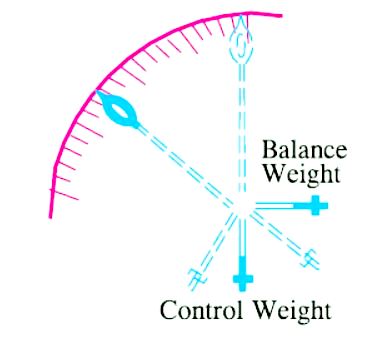
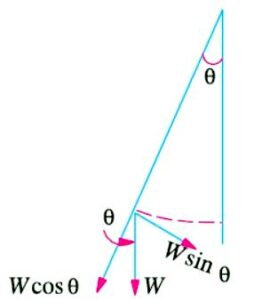
It will be seen from Figure (D) that as θ approaches 90º, the distance AB increases by a relatively small amount for a given change in the angle than when θ is just increasing from its zero value. Hence, gravity-controlled instruments have scales which are not uniform but are cramped or crowded at their lower ends as shown in Figure (E).
As compared to spring control, the disadvantages of gravity
control are :
1. it gives cramped scale
2. the instrument has to be kept vertical.
However, gravity control has the following advantages :
1. it is cheap
2. it is unaffected by temperature
3. it is not subjected to fatigue or deterioration with time.

(c) Damping Torque
A damping force is one which acts on the moving system of the instrument only when it is moving and always opposes its motion. Such stabilizing or damping force is necessary to bring the pointer to rest quickly, otherwise due to inertia of the moving system, the pointer will oscillate about its final deflected position for quite some time before coming to rest in the steady position. The degree of damping should be adjusted to a value which is sufficient to enable the pointer to rise quickly to its deflected position without overshooting. In that case, the instrument is said to be dead-beat. Any increase of damping above this limit i.e. overdamping will make the instruments slow and lethargic.
In Figure (F) is shown the effect of damping on the variation of position with time of the moving system of an instrument.
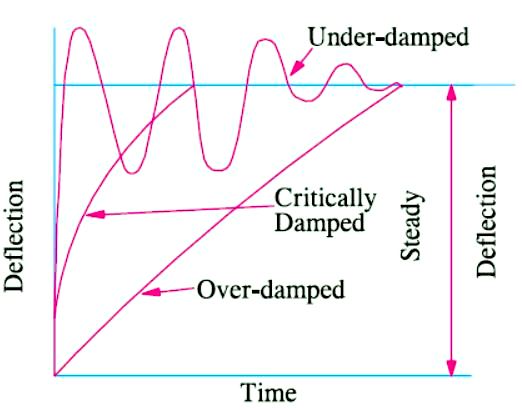
The damping force can be produced by (i) air frictions (ii) eddy currents and (iii) fluid friction (used occasionally).
Two methods of air-friction damping are shown in Figure (G) and (H). In Figure (F), the light aluminum piston attached to the moving system of the instrument is arranged to travel with

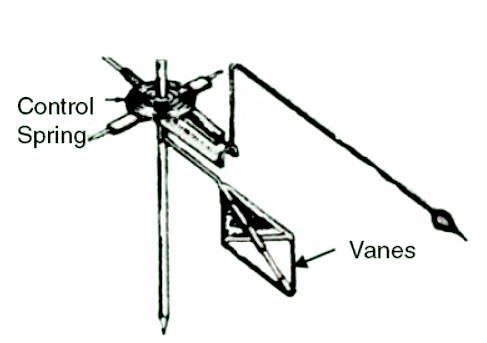
a very small clearance in a fixed air chamber closed at one end. The cross-section of the chamber is either circular or rectangular. Damping of the oscillation is affected by the compression and suction actions of the piston on the air enclosed in the chamber. Such a system of damping is not much favored these days, those shown in Figure (H) and (I) being preferred. In the latter method, one or two light aluminum vanes are mounted on the spindle of the moving system which move in a closed sector-shaped box as shown.
Fluid-friction is similar in action to the air friction. Due to greater viscosity of oil, the damping is more effective. However, oil damping is not much used because of several disadvantages such as objectionable creeping of oil, the necessity of using the instrument always in the vertical position and its obvious unsuitability for use in portable instruments.
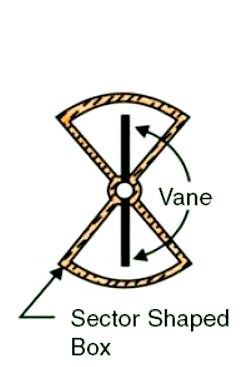
The eddy-current form of damping is the most efficient of the three. The two forms of such a damping are shown in Figure (J), (K) and (L) In Figure (J) is shown a thin disc of a conducting but non-magnetic material like copper or aluminum mounted on the spindle which carries the moving system and the pointer of the instrument. The disc is so positioned that its edges, when in rotation, cut the magnetic flux between the poles of a permanent magnet. Hence, eddy currents are produced in the disc which flow and so produce a damping force in such a direction as to oppose the very cause producing them (Lenz’s Law). Since the cause producing them is the rotation of the disc, these eddy current retard the motion of the disc and the moving system as a whole.
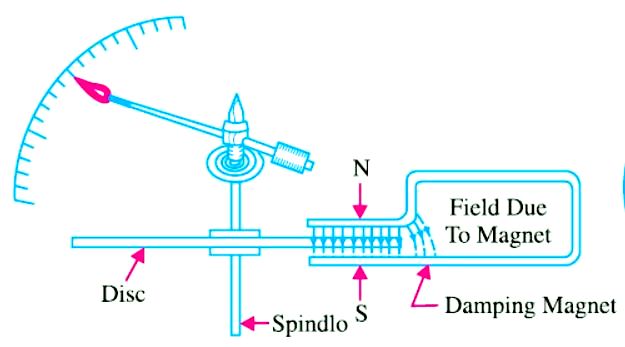
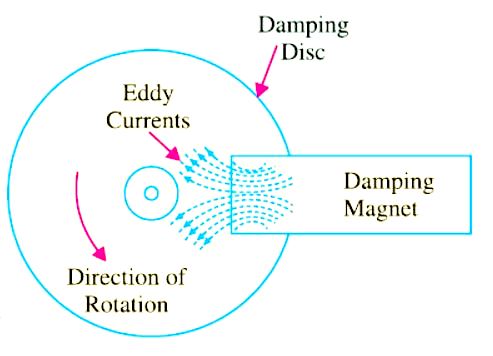
In Figure (L) is shown the second type of eddy-current damping generally employed in permanent-magnet moving coil instruments. The coil is wound on a thin light aluminum former in which eddy currents are produced when the coil moves in the field of the permanent magnet. The directions of the induced currents and of the damping force produced by them are shown in the figure (L).

Read article – Lenz’s Law
Visit NCERTplanet.com for NCERT solutions and Textbook downloads




